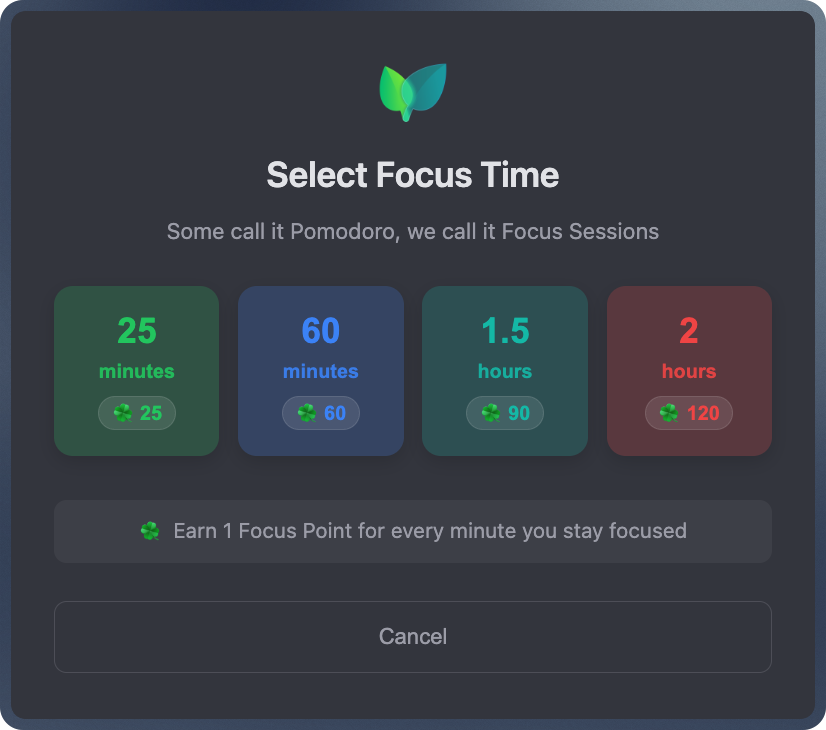
Leveling Up Your Life: How Gaming Mechanics Make Productivity Actually Not Suck
- TaskLeafTeam
- 01 Apr, 2025
- 09 Mins read
- Productivity , Psychology
Table of Contents
- Introduction
- The Psychology Behind Gamification
- How Points Make Tasks Actually Happen
- Task Completion
- Focus Session Multipliers
- Consistency Rewards (Coming Soon)
- Focus Sessions: The Productivity Powerhouse
- Why Timed Sessions Work So Damn Well
- The Game Layer
- The Flow State Hack
- The Science Behind It
- Leveling Up: Going Beyond Basic Points
- The Level System
- Achievement Badges (Coming Soon)
- Seeing Your Progress
- Progress Over Perfection
Introduction
Let’s be real—staying productive is brutal. Our phones are literally designed to keep us doom-scrolling, notifications are coming at us 24/7, and somehow TikTok always knows exactly how to keep us watching for “just five more minutes” (which turns into two hours). We’ve all been there: staring at our to-do list like 👁️👄👁️ while somehow ending up in a YouTube rabbit hole instead.
And don’t get me started on traditional productivity advice. “Just focus harder!” Yeah, OK boomer. Super helpful.
tip
What if getting stuff done could actually feel like… playing a game? What if the same brain zaps you get from unlocking a rare skin could happen when you finally finish that assignment you’ve been avoiding?
This is where gamification comes in—and no, it’s not just another buzzword your manager throws around. It’s literally about hijacking your brain’s reward system to make boring stuff feel worth doing. Same vibe as games, but for actual useful stuff.
When you turn your life into a game, weird things happen. Tasks that used to make you want to 💀 suddenly have stakes. That dopamine hit—the same one that keeps you playing “just one more round” at 3am—can actually make you want to do your work.
With points, focus timers, and level-ups, you start chasing the high of watching your productivity stats go up instead of just checking off boxes on a boring list.
Let’s gooo.
The Psychology Behind Gamification

Ever notice how you can stay up till 4am grinding on your favorite game but can’t focus on homework for 10 minutes without checking your phone? It’s not a skill issue—your brain is literally working as designed.
Our brains evolved to save energy and chase rewards. Cave people days: don’t waste energy unless there’s food or a mate as a reward. Now: our ancient monkey brains are getting absolutely played by games while our important work gives us zero dopamine.
The secret sauce is dopamine—that chemical that makes your brain go brrr when you accomplish something. Games are literally engineered to trigger these little brain zaps constantly.
Brain Science Tea
What’s wild is how predictable we all are. Studies show:
Reward Systems
- Random rewards (like sometimes getting extra points) are more addictive than predictable ones
- Progress bars create this weird psychological need to see them fill up
Task Structure
- Breaking big scary tasks into small wins makes impossible things feel doable
- Seeing other people’s scores makes us want to beat them (toxic but effective lol)
Visual Feedback
- Seeing your progress with cool visuals hits different than just knowing you did something
When I first tried using points for completing tasks, I thought it was kinda cringe. But after that first dopamine hit from seeing my points tick up, something clicked. I caught myself actually looking for more tasks to complete—not because I suddenly became that productive friend we all hate, but because my brain was now chasing that sweet, sweet reward.
The funniest part? Your brain literally can’t tell the difference between “real” rewards and fake ones. Those points and levels might just be pixels on a screen, but to your lizard brain, they hit just as hard as finding food did for our ancestors. We’re so easy to hack it’s embarrassing.
This isn’t just trust-me-bro science either. Microsoft saw 40% productivity jumps with gamification. Duolingo keeps millions of us pretending we’ll learn Spanish with their streak system. Even fitness apps trick us into moving our bodies when willpower alone would have us on the couch.
How Points Make Tasks Actually Happen
OK so enough theory—let’s talk about how turning productivity into a game actually works. Unlike your basic notes app, a gamified system gives you a whole economy around getting stuff done.
The basic currency is points, and there are a bunch of ways to earn them:
Task Completion
The simplest way to score points is by actually doing your tasks. But not all tasks give the same points:
note
- The hard/important stuff is worth more points (because they’re usually what you’re avoiding)
- Tasks with deadlines coming up get bonus multipliers (so you don’t leave everything until the last minute)
- Tasks that have been sitting forever get “staleness bonuses” (finally motivating you to deal with that thing from 3 months ago)
It’s wild how this changes your behavior. I used to always do the easy stuff first and leave the important stuff for “later” (aka never). Now I’m like, “Wait, this hard task is worth 50 points, while these three easy ones are only worth 10 each…” And just like that, I’m actually doing the stuff that matters first.
Focus Session Multipliers
Here’s where it gets kinda addictive. When you start a focus session, you’re basically entering a productivity power-up mode:
Point Earning
- You get points for each minute you stay focused (usually 1-2 points per minute)
- Completing tasks during focus sessions gives you extra multipliers
Bonuses (Coming Soon)
- Session completion bonuses for finishing without getting distracted
- Streak multipliers for doing multiple sessions back-to-back
- Special rewards for hitting focus milestones
The genius here is that it rewards both what you do AND how you do it. You could do random tasks throughout the day while checking Instagram every 3 minutes. But the real point jackpot comes from actually focusing.
One time I had this massive project I’d been avoiding forever. I broke it down into tasks, started a focus session, and got to work. Two hours later, not only was the project done, but I’d racked up over 300 points—enough to level up twice. That digital “level up” animation hits so different when it’s for actual work and not just killing digital dragons.
Consistency Rewards (Coming Soon)
Instead of just rewarding random bursts of productivity (we all know that one night before a deadline energy), the system is being built to reward actually showing up consistently:
- Daily streaks with increasing bonuses
- Weekly focus targets with special rewards
- Achievement badges for being consistent
- Monthly streak perks and power-ups
These features keep you coming back, not in the soul-sucking Instagram way, but by making consistency itself addictive.
I’m lowkey excited to hit my first 10-day streak when this launches. It won’t just be about the points—it’ll be actual proof I didn’t flake on myself for once.
Focus Sessions: The Productivity Powerhouse
Let’s talk about the real MVP of the gamification system: focus sessions. While points give you the “why” to be productive, focus sessions are the “how.”
Focus sessions are based on the Pomodoro Technique—a fancy name for “work for 25 minutes then take a break.” But the app takes this concept and gives it gaming steroids.
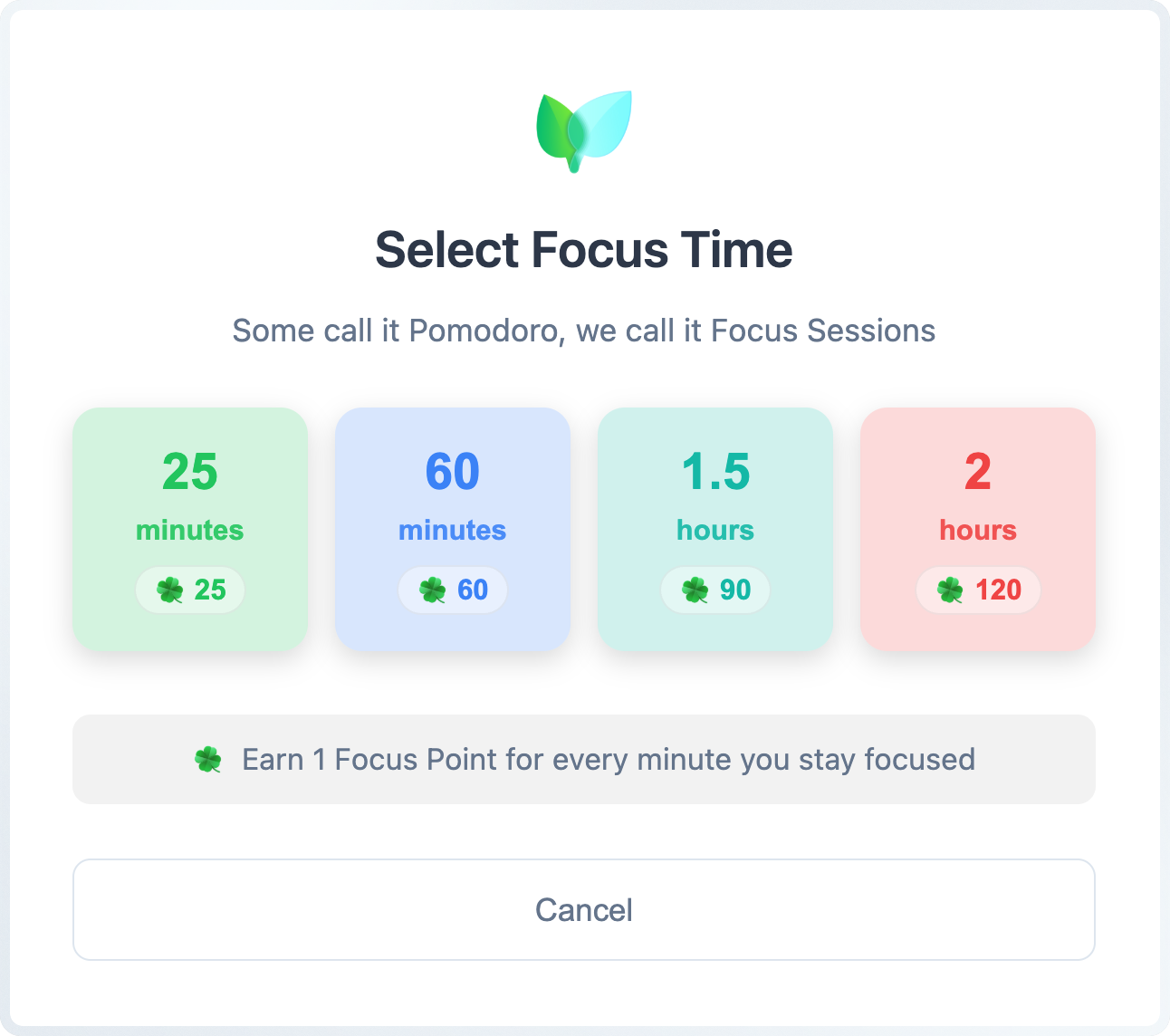
Why Timed Sessions Work So Damn Well
Ever notice how you can waste three hours scrolling through TikTok without blinking, but the thought of working for three hours straight makes you want to yeet yourself into the sun? That’s because our brains aren’t wired for marathon work sessions—they’re built for sprints.
Focus sessions use this psychology perfectly:
- The timer creates a finish line (“I only need to focus for 25 minutes, not forever”)
- The countdown creates urgency that kicks procrastination in the face
- The breaks keep you from burnout so your brain doesn’t melt
- The structure builds a flow to your work
When my friend first told me about focus sessions, I literally rolled my eyes so hard they almost fell out. “I don’t need a timer to tell me when to work,” I said like an absolute clown. Fast forward to today, and I can’t imagine working without them. There’s something about watching that timer count down that makes you think, “I can focus for just 10 more minutes before checking TikTok.”
The Game Layer
What makes these focus sessions different from just using a regular timer app is the game layer:
Visual Stuff
- The timer shows your progress in real-time
- Points pile up as you focus, giving you that sweet, sweet dopamine
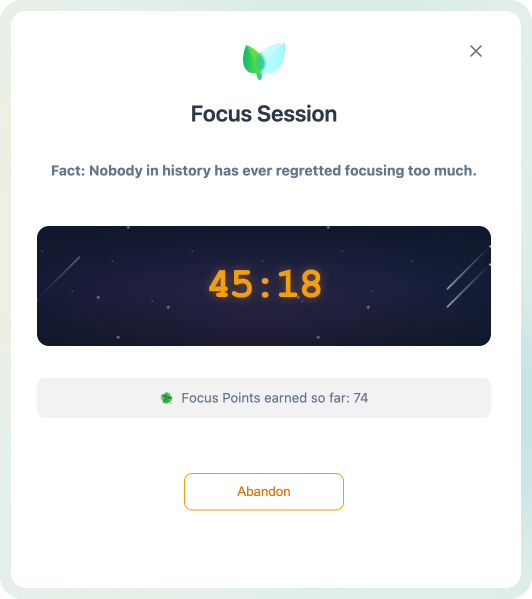
Achievements
- “Focus streaks” build up when you complete multiple sessions
- Special achievements unlock when you hit focus milestones
The first time I completed a full 25-minute session without checking my phone once (a minor miracle), I was pretty sure I time-traveled. Sounds stupid, but I felt lowkey proud of myself for what I did in those 25 minutes.
My Confession
The Flow State Hack
Here’s where it gets interesting. Sometimes you get into what fancy people call a “flow state”—that zone where you’re completely absorbed in your work and time just disappears.
The app is smart enough to recognize this and not mess with your vibe. When a focus session ends, it just asks if you want to keep going (with bonus points as bait). This simple feature has given me some of my most productive days ever.
Last month, I had a design project I’d been avoiding for weeks. I finally forced myself to start a focus session just to make some progress. Before I knew it, I was in the zone, and when asked if I wanted to continue, I smashed that “yes” button without thinking. Three sessions later, the whole project was done. The brain zap from seeing all those completed tasks—plus all those points—felt better than any validation on social media.
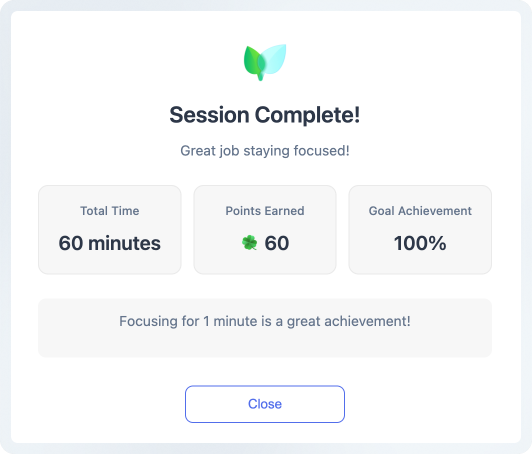
The Science Behind It
This isn’t just random app design—it’s based on actual brain science:
- Studies show our attention spans naturally cycle about every 25-30 minutes
- Most people can only focus deeply for 90-120 minutes before their brain needs a serious break
- Short breaks between work periods actually improve mental performance
- Having a timer means you don’t waste mental energy tracking time yourself
It’s basically combining science with game mechanics so you actually want to use them.
Leveling Up: Going Beyond Basic Points
Let’s be honest—collecting points is fun, but it gets boring if that’s all there is. This is where level progression comes in, turning your productivity into something that feels more like an RPG than a lame task list.
The Level System
You don’t just collect points—you level up. It works like this:
- Everyone starts at Level 1 (“Productivity Noob”)
- As you get points, you progress toward the next level
- Each level needs more points than the last (classic RPG style)
- Leveling up unlocks new features, customization options, and flex rights
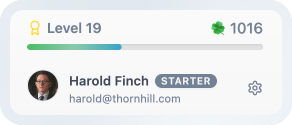
What’s wild is how fast this changed my relationship with getting stuff done. Instead of just checking off tasks, I started thinking like a gamer: “I’m only 200 points away from Level 10—what’s the fastest way to level up?”
This creates longer-term goals beyond just today’s to-do list. It’s like the difference between playing a quick mobile game versus getting deep into something like Skyrim or Elden Ring—there’s always another level to chase.
Achievement Badges (Coming Soon)
Along with levels are achievements—badges you earn for hitting specific milestones:
Focus Achievements
- “Focus Champion” for completing 50 focus sessions
- “Deep Work Master” for accumulating 24 hours of focus time
Task Achievements
- “Task Terminator” for completing 100 tasks
- “Consistency King/Queen” for maintaining a 30-day streak
These badges aren’t just digital flex material—they represent real productivity wins. When I got my first major badge, it hit me that I’d actually accomplished something tangible with my time. That’s something real, not just a game.
My friend Jake (who’s annoyingly productive) saw my badges when I was showing him the app. Next day, he downloaded it and started grinding toward the same achievements. Now we have this lowkey competition to see who can reach the next tier first. Nothing gets me moving like trying to beat someone else.
Seeing Your Progress
One of the most satisfying parts is how it visualizes your productivity journey. The app includes:
- A progress bar showing how close you are to leveling up
- Weekly and monthly point graphs
- Achievement showcases for your badges
- Stats comparing your current performance to past weeks
I never realized how motivating these visuals could be until I had a garbage unproductive week. Seeing my weekly graph tank was somehow more motivating than any lecture. The next week, I pushed hard to get that graph trending up again—not because someone was making me, but because I wanted to not suck.
Progress Over Perfection
The most important thing about the level system is that it focuses on progress, not perfection. Unlike those hardcore productivity systems where one slip-up means you failed, the level system recognizes that productivity is a marathon:
- Bad days don’t erase your progress
- You can have an unproductive day but still keep your level
- It’s about building up over time, not being perfect every day
This completely changed how I think about productive versus unproductive days. Instead of hating myself for a day where I get nothing done, I just think, “I’ll get back to earning points tomorrow.” It’s made productivity way less stressful and actually sustainable.